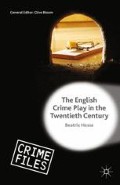Abstract
As John Russell Taylor observes in The Rise and Fall of the Well-Made Play, the term “plot construction” is acutely misleading, employing as it does an architectural metaphor although drama is a temporal art form. It is therefore not only appropriate to speak of “timing,” “time management” or “temporal organization” of a play rather than of “construction,” but also advisable to pay particular attention to the way in which the aspect of time is handled when analysing a play. Time management is also essential for the creation of suspense. Thus, Porter defines suspense as “a state of anxiety dependent on a timing device”1 and the “French crime writers Boileau/Narcejac, in their book Le Roman Policier ask the question: if we call this concept ‘suspense,’ exactly what is it that is being suspended? Their answer is: time.”2 François Truffaut ventures the definition of the “stretching of an anticipation”3 in his interview with suspense specialist Alfred Hitchcock.
Access this chapter
Tax calculation will be finalised at checkout
Purchases are for personal use only
Preview
Unable to display preview. Download preview PDF.
Notes
Dennis Porter, The Pursuit of Crime: Art and Ideology in Detective Fiction (New Haven and London: Yale UP, 1981), 29.
Charles Derry, The Suspense Thriller — Films in the Shadow of Alfred Hitchcock (Jefferson, NC, and London: McFarland, 1988), 32.
François Truffaut with the collaboration of Helen G. Scott, Hitchcock — Revised Edition (London: Truffaut/Hitchcock, 1986), 89.
Francis Durbridge, Deadly Nightcap (London: French, 1986), 35.
Anthony Shaffer, Murderer (London: Boyars, 1979), 50.
Erdmut August, Dramaturgie des Kriminalstücks — Untersuchung zur Intellektualisierung theatralischer Vorgänge am Beispiel einer neu ausgebildeten Gattung (PhD dissertation, München, 1961) 65f. (my translation). Since August’s dissertation is available only in German, it has not influenced criticism of detective fiction and the crime play to any noticeable extent.
In the use of the terms “theatre time” and “dramatic time” I am following Terry Hodgson, The Batsford Dictionary of Drama (London: Batsford, 1988), 399. Hodgson further subdivides “dramatic time” into “story time” and “plot time,” a distinction derived from Russian formalism, which will not be employed here, although the central difference between chronological representation and flashback will of course be considered.
J. B. Priestley, Man and Time (London: Star Books, 1978), 89.
Holger Klein, J. B. Priestley’s Plays (Basingstoke: Macmillan, 1988), 206f.
Aldous Huxley, The Gioconda Smile (London: Chatto and Windus, 1948), 113.
Booth mentions the examples of C. Z. Barnett’s Victorine; or, The Orphan of Paris of 1831 and James MacClosky’s The Fatal Glass; or, The Curse of Drink (1872).
Gene D. Phillips, Alfred Hitchcock (Boston: Twayne, 1984), 130.
Charles Osborne, The Life and Crimes of Agatha Christie (London: Collins, 1982), 34.
W. Somerset Maugham, “The Letter”, in: Stanley Richards (ed.), Best Mystery and Suspense Plays of the Modern Theatre (New York: Dodd, 1971), pp. 269–343, 335.
Guy Barefoot, “East Lynne to Gas Light — Hollywood, Melodrama and Twentieth-century Notions of the Victorian,” in: Jacky Bratton, Jim Cook, Christine Gledhill (eds.), Melodrama — Stage, Picture, Screen (London: British Film Institute, 1994), pp. 49–105; pp. 95–101.
Graham Greene, The Return of A. J. Raffles (London: Bodley Head, 1975), p. 9.
Author information
Authors and Affiliations
Copyright information
© 2015 Beatrix Hesse
About this chapter
Cite this chapter
Hesse, B. (2015). Timing and Plot “Construction”. In: The English Crime Play in the Twentieth Century. Crime Files Series. Palgrave Macmillan, London. https://doi.org/10.1057/9781137463043_8
Download citation
DOI: https://doi.org/10.1057/9781137463043_8
Publisher Name: Palgrave Macmillan, London
Print ISBN: 978-1-349-57517-6
Online ISBN: 978-1-137-46304-3
eBook Packages: Palgrave Literature CollectionLiterature, Cultural and Media Studies (R0)

